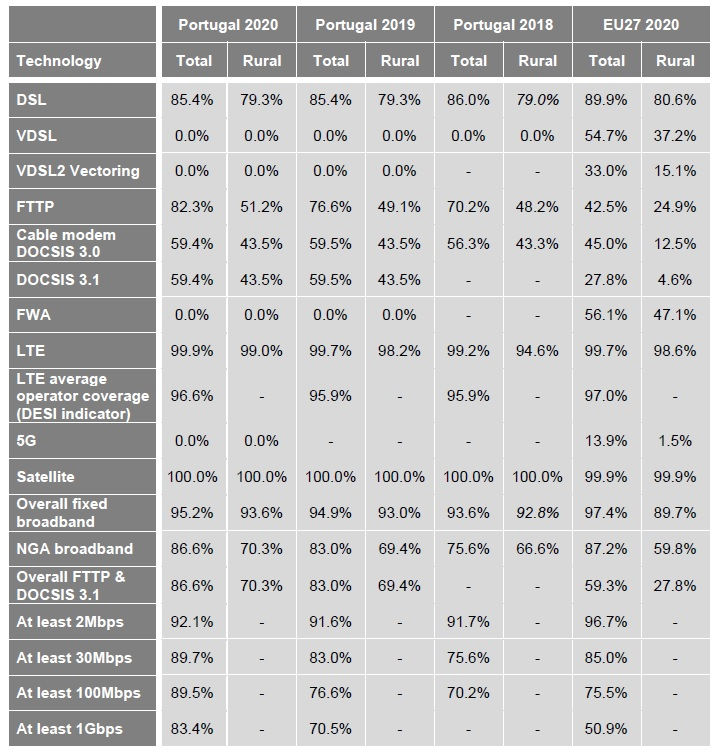Mapping Broadband Coverage in Portugal
- Point Topic
- Jun 13, 2022
- 3 min read
Updated: Jun 15, 2023
Find out more about Point Topic's sister company Expert Intelligence, specialising in market research and granular broadband mapping across mainland Europe.
National Coverage By Broadband Technology
By the end of June 2020, fixed broadband coverage reached 95.2% of all Portuguese households and 93.6% of rural households. NGA availability increased to reach 86.6% of homes at a national level and 70.3% at a rural level. Portugal came in just below the EU average for fixed broadband and NGA at a national level but surpassed the EU average for both categories at a rural level.
In terms of FTTP & DOCSIS 3.1 coverage, Portugal was one of the leaders in this category as 86.6% of homes were passed by at least one network potentially capable of delivering gigabit connection speeds. At a rural level, 70.3% of rural households had access to these services, more than twice the EU average of 27.8%.

In terms of individual technologies, DSL coverage remained unchanged at 85.4% after seeing decreasing coverage two years in a row from 86.0% in mid-2018. However, it remained the most widely available broadband technology in Portugal. As discussed in the previous iterations of this study, Portuguese operators have opted for FTTP deployment, rather than upgrading DSL to VDSL, explaining gradual disconnection of DSL networks in favour of fibre optic networks.
Therefore, in terms of NGA broadband, FTTP and cable modem DOCSIS 3.0/DOCSIS 3.1 were the only NGA technologies providing high speed broadband connectivity to Portuguese households. FTTP is increasing and almost the most prevalent technology, with 82.3% of homes passed, up from 76.6% one year previously. Cable modem DOCSIS 3.1 coverage remained static at reach 59.4% of households, the entirety of the network having been upgraded from DOCSIS 3.0 to DOCSIS 3.1.
LTE coverage continued to improve over the study period, to reach 99.9% of Portuguese households. However, there are differences in terms of reach of the individual mobile operators’ networks and as on average 96.6% of people in Portugal had access to LTE services, up from 95.9% in mid-2019.

156 IHS Markit, Omdia In terms of rural areas, DSL is still the most prevalent technology reaching 79.3% of households. In terms of NGA broadband, FTTP coverage improved over the study period, to reach more than half (51.2%) of rural Portuguese households, up from 49.1% in mid-2019. Cable modem DOCSIS 3.1 coverage remained relatively unchanged, at 43.5% of homes.
LTE coverage of rural areas improved again this year, to reach 99.0% of rural households, and with this increase, they beat the EU average of 98.6%. Commercial 5G coverage had not been implemented in Portugal as of June 2020.

157 IHS Markit, Omdia 5.24.2 Regional coverage by broadband technology In this iteration of the study, fixed broadband coverage levels continued to vary across Portuguese regions, with no region recording coverage below 80%. Coverage ranged from universal (100.0%) in Lisbon, down to 81.9% in Alto Minho. Only 5 of 25 Portuguese regions had fixed broadband availability below 90%.

NGA broadband availability varied more significantly than fixed broadband. NGA broadband levels varied between 52.9% in Douro and 100.0% in Lisbon. Six regions had NGA coverage above 90%, up from five in mid-2019.

The following broadband coverage levels were recorded in Portuguese regions outside mainland Europe:

Data Tables for Portugal


Note: The 2020 figures represent the state of broadband coverage at the end of June 2020. The 2019 (end of June) and 2018 (end of June) figures are drawn from the previous studies conducted by IHS Markit, Omdia, and Point Topic. All restatements are highlighted in italics.
Комментарии